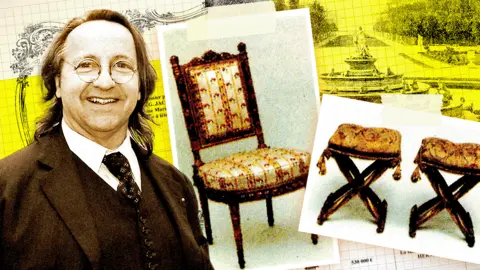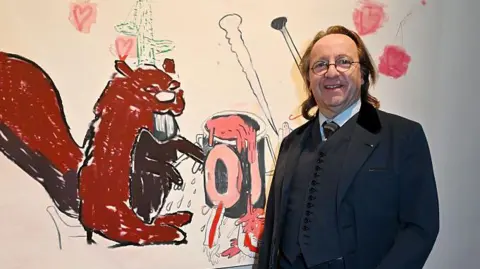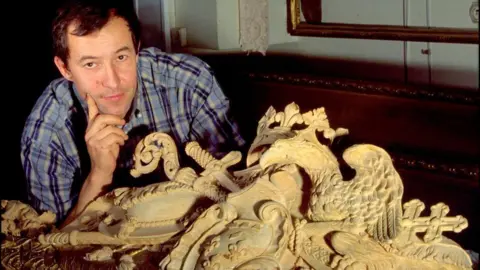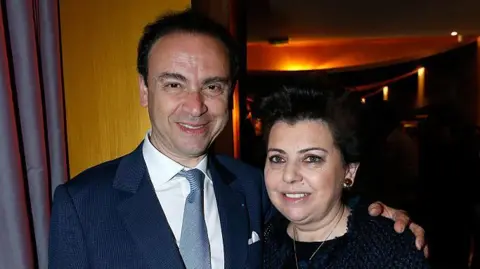/ Jun 07, 2025
Trending


 BBC
BBCIn the early 2010s, two ornate chairs said to have once belonged on the grounds of the Palace of Versailles appeared on the French antiques market.
Thought to be the most expensive chairs made for the last queen of France, Marie Antoinette, they were stamped with the seal of Nicolas-Quinibert Foliot, a celebrated – or carpenter – who worked in Paris in the 1700s.
A significant find, the pair were declared “national treasures” by the French government in 2013, at the request of Versailles.
The palace, which displays such items in its vast museum collection, expressed an interest in buying the chairs but the price was deemed too dear.
They were instead sold to Qatari Prince Mohammed bin Hamad Al Thani for an eye-watering €2m (£1.67m).
The chairs made up a remarkable number of 18th-Century royal furniture that had appeared on the antiques market in the past few years.
Other items included another set of chairs purported to have sat in one of Marie Antoinette’s chambers in Versailles; a separate pair said to have belonged to Madame du Barry, King Louis XV’s mistress; the armchair of King Louis XVI’s sister, Princess Élisabeth; and a pair of ployants – or stools – that belonged to the daughter of King Louis XV, Princess Louise Élisabeth.
Most of these were bought by Versailles to display in its museum collection, while one chair was sold to the wealthy Guerrand-Hermès family.
But in 2016, this assortment of royal chairs would become embroiled in a national scandal that would rock the French antiques world, bringing the trade into disrepute.
The reason? The chairs were in fact all fakes.
The scandal saw one of France’s leading antiques experts, Georges “Bill” Pallot, and award-winning cabinetmaker, Bruno Desnoues, put on trial on charges of fraud and money laundering following a nine-year investigation.

 Supplied
SuppliedGalerie Kraemer and its director, Laurent Kraemer, were also accused of deception by gross negligence for selling on some of the chairs – something they both deny.
All three defendants are set to appear at a court in Pontoise, near Paris on Wednesday following a trial in March. Mr Pallot and Mr Desnoues have admitted to their crimes, while Mr Kraemer and his gallery dispute the charge of deception by gross negligence.
Considered the top scholar on French 18th-Century chairs, having written the authoritative book on the subject, Mr Pallot was often called upon by Versailles, among others, to give his expert opinion on whether historical items were the real deal. He was even called as an expert witness in French courts when there were doubts about an item’s authenticity.
His accomplice, Mr Desnoues, was a decorated cabinetmaker and sculptor who had won a number of prestigious awards, including best sculptor in France in 1984, and had been employed as the main restorer of furniture at Versailles.
Speaking in court in March, Mr Pallot said the scheme started as a “joke” with Mr Desnoues in 2007 to see if they could replicate an armchair they were already working on restoring, belonging to Madame du Barry.
Masters of their crafts, they managed the feat, convincing other experts that it was a chair from the period.
And buoyed by their success, they started making more.

 Foc Kan/WireImage/Getty Images
Foc Kan/WireImage/Getty ImagesDescribing how they went about constructing the chairs, the two described in court how Mr Pallot sourced wood frames at various auctions for low prices, while Mr Desnoues aged wood at his workshop to make others.
They were then sent for gilding and upholstery, before Mr Desnoues added designs and a wood finish. He added stamps from some of the great furniture-workers of the 18th Century, which were either faked or taken from real furniture of the period.
Once they were finished, Mr Pallot sold them through middlemen to galleries like Kraemer and one he himself worked at, Didier Aaron. They would then get sold onto auction houses such as Sotheby’s of London and Drouot of Paris.
“I was the head and Desnoues was the hands,” Mr Pallot told the court smilingly.
“It went like a breeze,” he added. “Everything was fake but the money.”
Prosecutors allege the two men made an estimated profit of more than €3m off the forged chairs – though Mr Pallot and Mr Desnoues estimated their profits to be a lower amount of €700,000. The income was deposited in foreign bank accounts, prosecutors said.

 Getty Images
Getty ImagesLawyers representing Versailles told the BBC that Mr Pallot, a lecturer at the Sorbonne, managed to deceive the institution because of his “privileged access to the documentation and archives of Versailles and the Louvre Museum as part of his academic research”.
A statement from lawyer Corinne Hershkovitch’s team said that thanks to Mr Pallot’s “thorough knowledge” of the inventories of royal furniture recorded as having existed at Versailles in the 18th Century, he was able to determine which items were missing from collections and to then make them with the help of Mr Desnoues.
Mr Desnoues also had access to original chairs he had made copies of, they added, “enabling him to produce fakes that had all the visual appearance of an authentic, up to the inventory numbers and period labels”.
“The fraudulent association between these two professionally accomplished men, recognised by their peers, made it possible to deceive the French institutions that regarded them as partners and to betray their trust, thereby damaging the reputation of Versailles and its curators,” they said.
Prosecutor Pascal Rayer said the trial highlighted the need for more robust regulation of the art market, and also shone a light on the standards antiques dealers should abide by.
The court heard authorities were alerted to the scheme when the lavish lifestyle of a Portuguese man and his partner caught the attention of French authorities.
Questioned by police about the acquisition of properties in France and Portugal worth €1.2m while on an income of about €2,500 a month, the man – who it turned out worked as a handyman in Parisian galleries – confessed to his part in working as a middleman who collaborated in the furniture fraud, AFP news agency reported. The money trail then led investigators to Mr Desnoues and Mr Pallot.
Some of those originally indicted in the case, including middlemen, later had charges against them dropped.
But charges against both Laurent Kraemer and Galerie Kraemer, which sold on some of the forged chairs to collectors such as Versailles and Qatar’s Prince al-Thani, were upheld.
Prosecutors allege that while the gallery itself may have been duped into first buying the fake pieces, Mr Kraemer and the gallery were “grossly negligent” in failing to sufficiently check the items’ authenticity before selling them on to collectors at high prices.

 Getty Images
Getty ImagesIn his closing arguments, prosecutor Mr Rayer said that based on Galerie Kraemer’s “reputation and contacts, they could have taken the furniture to Versailles or the Louvre to compare them.
“They could also have hired other experts given the amounts at stake and considering the opacity on the origin of the chairs.”
Speaking in court, a lawyer representing Mr Kraemer and the gallery insisted his client “is victim of the fraud, not an accomplice”, stating Mr Kraemer never had direct contact with the forgers.
In a statement to the BBC, lawyers Martin Reynaud and Mauricia Courrégé added: “The gallery was not an accomplice of the counterfeiters, the gallery did not know the furniture was fake, and it could not have detected it”.
“Like the Château de Versailles and the specialists who classified the furniture as national treasures, the Kraemer gallery was a victim of the forgers,” they added.
“We are waiting for the judgement to recognise this.”
The BBC has contacted Mr Pallot’s lawyer for comment. The BBC was unable to reach Mr Desnoues or his lawyer.

 BBC
BBCIn the early 2010s, two ornate chairs said to have once belonged on the grounds of the Palace of Versailles appeared on the French antiques market.
Thought to be the most expensive chairs made for the last queen of France, Marie Antoinette, they were stamped with the seal of Nicolas-Quinibert Foliot, a celebrated – or carpenter – who worked in Paris in the 1700s.
A significant find, the pair were declared “national treasures” by the French government in 2013, at the request of Versailles.
The palace, which displays such items in its vast museum collection, expressed an interest in buying the chairs but the price was deemed too dear.
They were instead sold to Qatari Prince Mohammed bin Hamad Al Thani for an eye-watering €2m (£1.67m).
The chairs made up a remarkable number of 18th-Century royal furniture that had appeared on the antiques market in the past few years.
Other items included another set of chairs purported to have sat in one of Marie Antoinette’s chambers in Versailles; a separate pair said to have belonged to Madame du Barry, King Louis XV’s mistress; the armchair of King Louis XVI’s sister, Princess Élisabeth; and a pair of ployants – or stools – that belonged to the daughter of King Louis XV, Princess Louise Élisabeth.
Most of these were bought by Versailles to display in its museum collection, while one chair was sold to the wealthy Guerrand-Hermès family.
But in 2016, this assortment of royal chairs would become embroiled in a national scandal that would rock the French antiques world, bringing the trade into disrepute.
The reason? The chairs were in fact all fakes.
The scandal saw one of France’s leading antiques experts, Georges “Bill” Pallot, and award-winning cabinetmaker, Bruno Desnoues, put on trial on charges of fraud and money laundering following a nine-year investigation.

 Supplied
SuppliedGalerie Kraemer and its director, Laurent Kraemer, were also accused of deception by gross negligence for selling on some of the chairs – something they both deny.
All three defendants are set to appear at a court in Pontoise, near Paris on Wednesday following a trial in March. Mr Pallot and Mr Desnoues have admitted to their crimes, while Mr Kraemer and his gallery dispute the charge of deception by gross negligence.
Considered the top scholar on French 18th-Century chairs, having written the authoritative book on the subject, Mr Pallot was often called upon by Versailles, among others, to give his expert opinion on whether historical items were the real deal. He was even called as an expert witness in French courts when there were doubts about an item’s authenticity.
His accomplice, Mr Desnoues, was a decorated cabinetmaker and sculptor who had won a number of prestigious awards, including best sculptor in France in 1984, and had been employed as the main restorer of furniture at Versailles.
Speaking in court in March, Mr Pallot said the scheme started as a “joke” with Mr Desnoues in 2007 to see if they could replicate an armchair they were already working on restoring, belonging to Madame du Barry.
Masters of their crafts, they managed the feat, convincing other experts that it was a chair from the period.
And buoyed by their success, they started making more.

 Foc Kan/WireImage/Getty Images
Foc Kan/WireImage/Getty ImagesDescribing how they went about constructing the chairs, the two described in court how Mr Pallot sourced wood frames at various auctions for low prices, while Mr Desnoues aged wood at his workshop to make others.
They were then sent for gilding and upholstery, before Mr Desnoues added designs and a wood finish. He added stamps from some of the great furniture-workers of the 18th Century, which were either faked or taken from real furniture of the period.
Once they were finished, Mr Pallot sold them through middlemen to galleries like Kraemer and one he himself worked at, Didier Aaron. They would then get sold onto auction houses such as Sotheby’s of London and Drouot of Paris.
“I was the head and Desnoues was the hands,” Mr Pallot told the court smilingly.
“It went like a breeze,” he added. “Everything was fake but the money.”
Prosecutors allege the two men made an estimated profit of more than €3m off the forged chairs – though Mr Pallot and Mr Desnoues estimated their profits to be a lower amount of €700,000. The income was deposited in foreign bank accounts, prosecutors said.

 Getty Images
Getty ImagesLawyers representing Versailles told the BBC that Mr Pallot, a lecturer at the Sorbonne, managed to deceive the institution because of his “privileged access to the documentation and archives of Versailles and the Louvre Museum as part of his academic research”.
A statement from lawyer Corinne Hershkovitch’s team said that thanks to Mr Pallot’s “thorough knowledge” of the inventories of royal furniture recorded as having existed at Versailles in the 18th Century, he was able to determine which items were missing from collections and to then make them with the help of Mr Desnoues.
Mr Desnoues also had access to original chairs he had made copies of, they added, “enabling him to produce fakes that had all the visual appearance of an authentic, up to the inventory numbers and period labels”.
“The fraudulent association between these two professionally accomplished men, recognised by their peers, made it possible to deceive the French institutions that regarded them as partners and to betray their trust, thereby damaging the reputation of Versailles and its curators,” they said.
Prosecutor Pascal Rayer said the trial highlighted the need for more robust regulation of the art market, and also shone a light on the standards antiques dealers should abide by.
The court heard authorities were alerted to the scheme when the lavish lifestyle of a Portuguese man and his partner caught the attention of French authorities.
Questioned by police about the acquisition of properties in France and Portugal worth €1.2m while on an income of about €2,500 a month, the man – who it turned out worked as a handyman in Parisian galleries – confessed to his part in working as a middleman who collaborated in the furniture fraud, AFP news agency reported. The money trail then led investigators to Mr Desnoues and Mr Pallot.
Some of those originally indicted in the case, including middlemen, later had charges against them dropped.
But charges against both Laurent Kraemer and Galerie Kraemer, which sold on some of the forged chairs to collectors such as Versailles and Qatar’s Prince al-Thani, were upheld.
Prosecutors allege that while the gallery itself may have been duped into first buying the fake pieces, Mr Kraemer and the gallery were “grossly negligent” in failing to sufficiently check the items’ authenticity before selling them on to collectors at high prices.

 Getty Images
Getty ImagesIn his closing arguments, prosecutor Mr Rayer said that based on Galerie Kraemer’s “reputation and contacts, they could have taken the furniture to Versailles or the Louvre to compare them.
“They could also have hired other experts given the amounts at stake and considering the opacity on the origin of the chairs.”
Speaking in court, a lawyer representing Mr Kraemer and the gallery insisted his client “is victim of the fraud, not an accomplice”, stating Mr Kraemer never had direct contact with the forgers.
In a statement to the BBC, lawyers Martin Reynaud and Mauricia Courrégé added: “The gallery was not an accomplice of the counterfeiters, the gallery did not know the furniture was fake, and it could not have detected it”.
“Like the Château de Versailles and the specialists who classified the furniture as national treasures, the Kraemer gallery was a victim of the forgers,” they added.
“We are waiting for the judgement to recognise this.”
The BBC has contacted Mr Pallot’s lawyer for comment. The BBC was unable to reach Mr Desnoues or his lawyer.
It is a long established fact that a reader will be distracted by the readable content of a page when looking at its layout. The point of using Lorem Ipsum is that it has a more-or-less normal distribution
The Us Media 2025